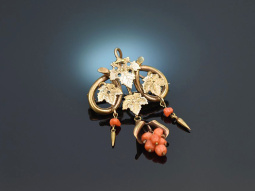Biedermeier Brooches
(1820 - 1870)
Brooches are one of the most popular pieces of Biedermeier jewellery. It is therefore not surprising that Biedermeier brooches were produced in numerous variations. Due to their special design, they also became affordable for the bourgeoisie, so that a broad section of the population could now adorn themselves in the style of the aristocracy. Learn more »
How were Biedermeier brooches made?

Biedermeier jewellery was mostly factory-made. Individual pieces of jewellery were pressed by machine and then assembled by hand. This resulted in affordable jewellery that could be worn by everyone.
In order to save material, gold was rolled thin and pressed into three-dimensional objects, which were then filled with putty, resin and sand to stabilise them. The so-called foam gold brooch was born. Metal alloys such as Tombak and Pinchbeck were also used, which imitated gold in their colouring.
Which ornaments characterize Biedermeier jewellery?
Antique brooches made of foam gold were quite opulent in the Biedermeier period. Geometric shapes such as rectangles, ovals and rhombuses were richly decorated with volutes, foliage, flowers and fruits.
From 1840 onwards, the rocaille was preferred and the ornament was used in different variations. Pendant chains on brooches were popular and were designed as tassels or pompons.
Were there different types of brooches?
Yes. A clear trend of the early Biedermeier period was the so-called Sévigné brooch. This is a brooch with a transverse oval centre motif (often in the form of a bow) with three tassels. From 1835, the latter was reduced to a single pendant.
Another favourite of Biedermeier society were picture brooches. Small paintings made of enamel or porcelain were set into brooches and could contain genre scenes, religious motifs or landscapes. If you had the necessary budget, you could have a personalised portrait of your own husband made.
Which gemstones can be found in Biedermeier brooches?

Multicoloured stones are typical of 19th century jewellery. Particularly popular gemstones were garnet, amethyst and turquoise as well as finely shimmering pearls and coral from Italy. Large, centrally set gemstones or cameos surrounded by ornamentation were also in demand.
How was Biedermeier jewellery worn?
Biedermeier brooches were often fitted with hinged eyelets so that one and the same piece of jewellery could be worn as a pendant and as a brooch at the same time. The latter always sat in the centre of the garment and adorned the neckline of the dress.
High-quality Biedermeier brooches made of gold were often also made as part of a parure, i.e. a jewellery set that was precisely coordinated in style and design.
Brooches were therefore often worn in combination with matching Biedermeier earrings or Biedermeier rings.





